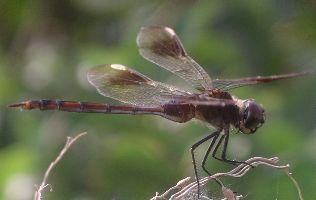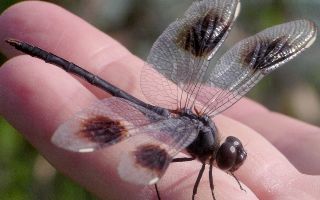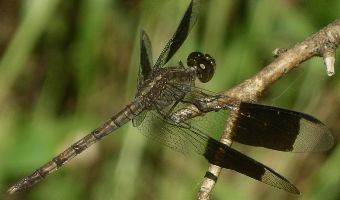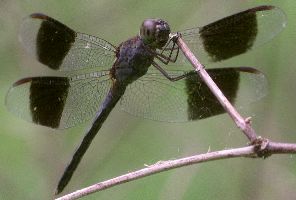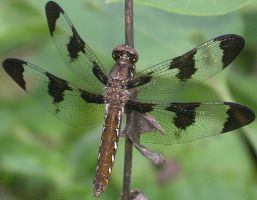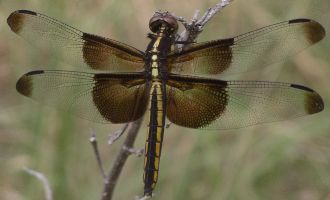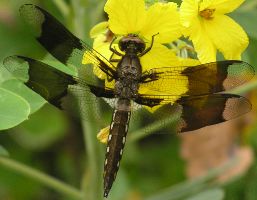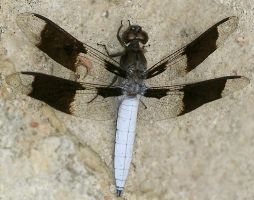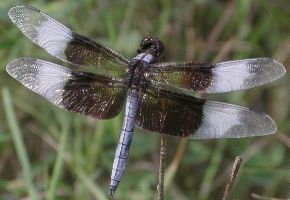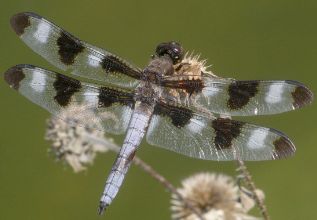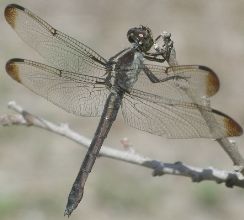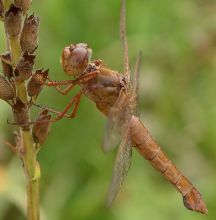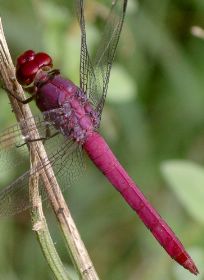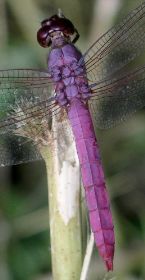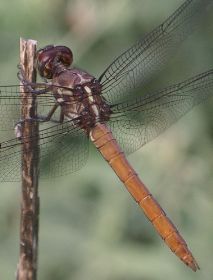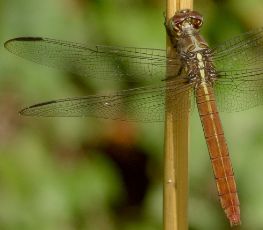
| Libellulidae ~ Skimmers |
|
Sometimes the wing patterns are so distinctive that no other clues are necessary for identification. Such is the case with the Four-spotted Pennant (Brachymesia gravida). It is the only dragonfly with a rounded spot and a white stigma (the little opaque mark on the leading edge of the wing near the tip) on each wing. This can be a very common dragonfly at times, but they are difficult to approach. Other characteristics include a very slender abdomen that is quite swollen at the base, and brown color in the female and black in the male.
Another slender dark dragonfly with a large dark mark on each wing is the Band-winged Dragonlet (Erythrodiplax umbrata). Unlikely to be mistaken for the previous species, this one has full squared off black marks on each wing. The base of the abdomen is not swollen. Females and immature males are brown and mature males are black.
One of the most distinctive skimmers is the Common Whitetail (Plathemis lydia), a stout dragonfly that often perches on the ground or hangs vertically from low vegetation. Mature males have a brilliant white abdomen and black thorax and face. The wing pattern includes a large black band and a small basal bar on each wing. Immature males have the same wing pattern but their bodies are colored like the female. Females have a brown body with white marks along the sides of each abdominal segment. The wing pattern includes the basal dashes, as well as black tips and a black smudge in the center of the wing.
The Widow Skimmer (Libellula luctuosa) is not easy to mistake for the previous species, but I find that I often forget which name belongs to which species. Another stoutly shaped insect, mature male Widow Skimmers have a white abdomen as well as white on the front of the thorax. An interesting characteristic about the chalky white on several male dragonflies, including this species, is that it wears off on the sides during mating, as the female grasps the male's abdomen; it is possible to tell if a male has mated by the presence of the worn darker areas. The basal half of the wings are dark, with the outer half being white with clear tips. The amount of white varies, being much less evident in young males. Females have dark wing bases and tips and no white. Their dark bodies have striking yellow stripes down the sides of the abdomen which meet at the thorax and continue to the head as a single dorsal stripe. Young males have the body markings of a female. One more white-bodied skimmer that I've only seen occasionally is the stunning Twelve-spotted Skimmer (Libellula pulchella). The wings of the male have black spots at the base, middle and tip, with corresponding white patches in between.
While I'm discussing species I only see rarely, the Comanche Skimmer (Libellula comanche) also deserves note. I've seen one male, a large chalk blue dragonfly with a white face and stigma that is mostly white with a black bit towards the tip of the wing. Another occasional sighting is the Slaty Skimmer (Libellula incesta). For some reason, I've only seen females of this one. They are frustratingly difficult to distinguish from the females of the Great Blue Skimmer (Libellula vibrans), as size is one of the main clues (the Slaty Skimmer is smaller) and markings on wings and body are variable, especially between young and old specimens. As evident in the accompanying photo, the female Slaty Skimmer has a wide flange near the tip of the abdomen, a gray dorsal stripe on the thorax, and light stripes down the abdomen that become obscured as the individual ages.
One of the most common skimmers is the Neon Skimmer (Libellula croceipennis). It also happens to be one of the most brightly colored of any dragonfly, with males sporting a glowing red abdomen. Young males are brown like females and only gradually become red. Because this is one of the species that inhabits our backyard pond, I've watched them more than just about any other dragonfly. The males are highly territorial and will attack anything red, including Ruby-throated Hummingbirds and my shirt. The male also guards the area while the female lays eggs.
Female Neon Skimmers are a golden brown color and are very stout. They have a wide flange near the tip of their abdomen and when they lay eggs, this causes a drop of water to splash several inches away. The females lay one egg at a time and they do it by flying in repeated circles and dipping into the water each time. The splash often distracts our fish away from the egg, which floats slowly down into the water. Even with the splash decoy, I'm surprised that any eggs make it past the voracious jaws of the fish.
There are two other skimmer species which are about as stunning a color as possible. The Roseate Skimmer (Orthemis ferruginea) is fairly common and males are a purple or magenta color. This unusual hue is attained by their underlying red color being covered with a translucent blue pruinescence. It is beautiful. There is also a very similar species, mysteriously only seen in conjunction with the Roseate Skimmer, the Carmine Skimmer (Orthemis discolor). This one is much less common and males are not quite as purple, but more of a hot pink color. The head of the male Roseate Skimmer is very dark while that of the male Carmine Skimmer is bright red. Immature males are the same color as females, but I'm not sure I've ever seen an immature male Carmine Skimmer.
The female Roseate Skimmer is brown, with several white stripes on the thorax and a white stripe down the top of the thorax and onto the abdomen but it stops partway down. The abdomen has a flange near the tip (a useful clue in separating immature males from females). Female Carmine Skimmers are much the same, but the eyes are more red than those of the Roseate Skimmer. Another trait which may or may not be reliable to separate the species are the white spots that occur behind the eyes of female and young male Roseate Skimmers, usually easily seen in photos. These are lacking on the female Carmine Skimmer, as well as mature males of both species. These observations are just my attempt to sort the two species out. I've seen far more Roseate Skimmers than Carmine Skimmers, so the sampling is not very good. |
![]()
